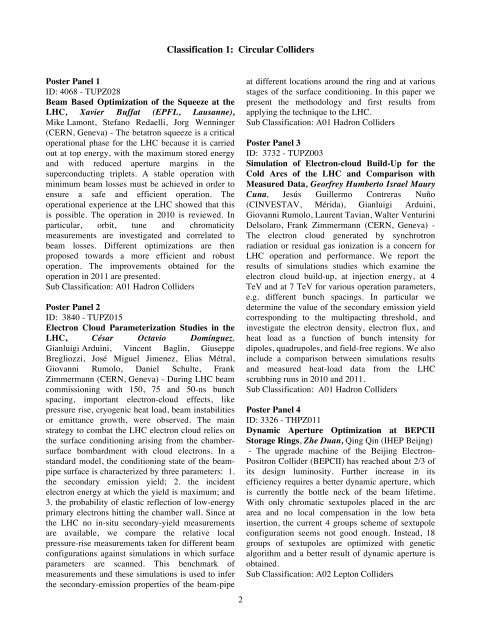Abstracts Brochure - 2nd International Particle Accelerator Conference
Abstracts Brochure - 2nd International Particle Accelerator Conference
Abstracts Brochure - 2nd International Particle Accelerator Conference
You also want an ePaper? Increase the reach of your titles
YUMPU automatically turns print PDFs into web optimized ePapers that Google loves.
Poster Panel 1<br />
ID: 4068 - TUPZ028<br />
Beam Based Optimization of the Squeeze at the<br />
LHC, Xavier Buffat (EPFL, Lausanne),<br />
Mike Lamont, Stefano Redaelli, Jorg Wenninger<br />
(CERN, Geneva) - The betatron squeeze is a critical<br />
operational phase for the LHC because it is carried<br />
out at top energy, with the maximum stored energy<br />
and with reduced aperture margins in the<br />
superconducting triplets. A stable operation with<br />
minimum beam losses must be achieved in order to<br />
ensure a safe and efficient operation. The<br />
operational experience at the LHC showed that this<br />
is possible. The operation in 2010 is reviewed. In<br />
particular, orbit, tune and chromaticity<br />
measurements are investigated and correlated to<br />
beam losses. Different optimizations are then<br />
proposed towards a more efficient and robust<br />
operation. The improvements obtained for the<br />
operation in 2011 are presented.<br />
Sub Classification: A01 Hadron Colliders<br />
Poster Panel 2<br />
ID: 3840 - TUPZ015<br />
Electron Cloud Parameterization Studies in the<br />
LHC, César Octavio Domínguez,<br />
Gianluigi Arduini, Vincent Baglin, Giuseppe<br />
Bregliozzi, José Miguel Jimenez, Elias Métral,<br />
Giovanni Rumolo, Daniel Schulte, Frank<br />
Zimmermann (CERN, Geneva) - During LHC beam<br />
commissioning with 150, 75 and 50-ns bunch<br />
spacing, important electron-cloud effects, like<br />
pressure rise, cryogenic heat load, beam instabilities<br />
or emittance growth, were observed. The main<br />
strategy to combat the LHC electron cloud relies on<br />
the surface conditioning arising from the chambersurface<br />
bombardment with cloud electrons. In a<br />
standard model, the conditioning state of the beampipe<br />
surface is characterized by three parameters: 1.<br />
the secondary emission yield; 2. the incident<br />
electron energy at which the yield is maximum; and<br />
3. the probability of elastic reflection of low-energy<br />
primary electrons hitting the chamber wall. Since at<br />
the LHC no in-situ secondary-yield measurements<br />
are available, we compare the relative local<br />
pressure-rise measurements taken for different beam<br />
configurations against simulations in which surface<br />
parameters are scanned. This benchmark of<br />
measurements and these simulations is used to infer<br />
the secondary-emission properties of the beam-pipe<br />
�<br />
Classification 1: Circular Colliders<br />
2<br />
at different locations around the ring and at various<br />
stages of the surface conditioning. In this paper we<br />
present the methodology and first results from<br />
applying the technique to the LHC.<br />
Sub Classification: A01 Hadron Colliders<br />
Poster Panel 3<br />
ID: 3732 - TUPZ003<br />
Simulation of Electron-cloud Build-Up for the<br />
Cold Arcs of the LHC and Comparison with<br />
Measured Data, Georfrey Humberto Israel Maury<br />
Cuna, Jesús Guillermo Contreras Nuño<br />
(CINVESTAV, Mérida), Gianluigi Arduini,<br />
Giovanni Rumolo, Laurent Tavian, Walter Venturini<br />
Delsolaro, Frank Zimmermann (CERN, Geneva) -<br />
The electron cloud generated by synchrotron<br />
radiation or residual gas ionization is a concern for<br />
LHC operation and performance. We report the<br />
results of simulations studies which examine the<br />
electron cloud build-up, at injection energy, at 4<br />
TeV and at 7 TeV for various operation parameters,<br />
e.g. different bunch spacings. In particular we<br />
determine the value of the secondary emission yield<br />
corresponding to the multipacting threshold, and<br />
investigate the electron density, electron flux, and<br />
heat load as a function of bunch intensity for<br />
dipoles, quadrupoles, and field-free regions. We also<br />
include a comparison between simulations results<br />
and measured heat-load data from the LHC<br />
scrubbing runs in 2010 and 2011.<br />
Sub Classification: A01 Hadron Colliders<br />
Poster Panel 4<br />
ID: 3326 - THPZ011<br />
Dynamic Aperture Optimization at BEPCII<br />
Storage Rings, Zhe Duan, Qing Qin (IHEP Beijng)<br />
- The upgrade machine of the Beijing Electron-<br />
Positron Collider (BEPCII) has reached about 2/3 of<br />
its design luminosity. Further increase in its<br />
efficiency requires a better dynamic aperture, which<br />
is currently the bottle neck of the beam lifetime.<br />
With only chromatic sextupoles placed in the arc<br />
area and no local compensation in the low beta<br />
insertion, the current 4 groups scheme of sextupole<br />
configuration seems not good enough. Instead, 18<br />
groups of sextupoles are optimized with genetic<br />
algorithm and a better result of dynamic aperture is<br />
obtained.<br />
Sub Classification: A02 Lepton Colliders


